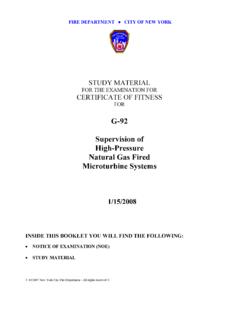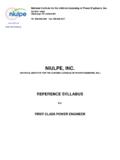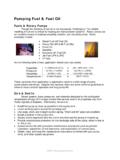Transcription of This page intentionally left blank. - irs.gov
1 This page intentionally left OF CONTENTSOIL AND GAS INDUSTRYI ndex to ixChapter 1, oil and gas 1-1 General Description of the 1-2 Mineral 1-2 Acquisition Through Mineral 1-2 Acquisition in 1-3 Property 1-7 Types of Ownership 1-8 Tract or 1-8 Separate 1-8 Accounting 1-9 Successful Efforts 1-9 Full Cost 1-11 Accounting 1-12 Chapter 2, oil and gas Industry IssuesIssues Related to an oil and gas Entity and Activity -- 2-1 Unproductive 2-1 Productive 2-1 Unique 2-2 Uniform Capitalization 2-4 Assistance in IRC Section 2-5 General Issues [Non- oil and gas ].. 2-5 Chapter 3, oil and gas Audit TechniquesExamination of an oil and gas Entity and 3-1 Engineering 3-1 Initial Interview 3-2 Initial Information Document 3-3 Accounting 3-4iiiProperty 3-7 Areas Typical of an oil and gas 3-8 Gross 3-8 Lease 3-10 Delay 3-11 Royalty 3-11 Advance 3-11 Minimum 3-12 Shut in 3-12 Production 3-13 Shooting 3-13 Uniform Capitalization Rules - IRC section 3-16 Produced 3-16 Predevelopment 3-17 Interest 3-18 Allocation of Indirect 3-19 Auditing 3-19 Leasehold 3-20 Geological and Geophysical 3-22 Abandonment 3-25 Audit 3-27 Lease Operating 3-30 Bad Debts (Joint Interest Owners).
2 3-32 Intangible Drilling 3-34 Audit 3-37 Lease and Well 3-40 Economic 3-41 Cost 3-41 Units 3-42 Adjusted Basis of 3-42 Cost Depletion on Wildcat 3-43 Percentage 3-44 Independent 3-44 Transfers of Proven 3-44 Gross Income from the 3-45 Net Income of the 3-47 Expenses of the 3-49 Overhead 3-49 Audit 3-50 Information Required to Compute Depletion 3-50 Alternative Minimum 3-52 Percentage 3-52 Intangible Drilling 3-52 Alternative Tax Energy Preference 3-53ivQualified Exploratory 3-53 Marginal 3-54 Phase Out of the 3-55 Audit 3-55 Alternative Tax Energy Preference 3-57 Self-Employment 3-57 Passive Activity Loss 3-58 oil and gas 3-59 Portfolio 3-59 Chapter 4, Financial ProductsPotential Area of Concern Related to Oil and 4-1 Energy Markets and the 4-1 Cash 4-1 Forward 4-5 Futures 4-5 Options 4-8 Market Participants in Forward and Futures 4-11 Commodity Notional 4-13 Commodity Notional 4-13 Use of Commodity Notional Swap to Hedge G-1 Technical ReferencesGeneral Counsel Memorandums (GCM)
3 And Court TR-1 Revenue RulingsTR-2 Assignments, Sales and TR-2 Capital TR-2 Definition of TR-4 Cost TR-4 Depletion, Gross Income, Net TR-4 Percentage TR-6 Geological and Geophysical TR-6 Intangible Drilling and Development TR-6 Nonconventional Fuel TR-7 Nonrecourse TR-8 Sharing TR-8vThis page intentionally left TO and Gas LeasePetroleum companies obtain the rights to explore, drill, andand Mineral Deedproduce subsurface minerals by entering into an oil and gasagreement or "lease" with the landowner. An oil and gas leaseembodies the legal rights, privileges and duties pertaining tothe lessor and lessee. The lessor is the mineral interest ownerwho transfers the working interest to the lessee who retains aroyalty interest. The mineral lease is a very important legaldocument to the petroleum industry and provides theframework for all the activities that follow.
4 It can be a usefulauditing tool, because it provides a description of the property,identifies the royalty owner, and can give details of such itemsas delay rentals, lease bonus, unitizations, and primary a joint interest situation is created, the parties involvedProcedure( , the operator and nonoperators) generally execute anAccompanying aoperating agreement. The normal form used for the operatingJoint Operatingagreement is AAPL Form 601. The joint operating agreementAgreementdelineates the responsibilities and duties of the operator andnonoperators. It may cover only drilling operations, or it maycover both, exploration and OrderPrior to the sale of oil or gas covered by a particular lease, adivision order is prepared and signed by all interest owners. The division order is a necessary instrument in order for theoperator to orderly and legally collect the oil and gas revenuesand to pay the correct owners of the of InterestFor accounting purposes, the information on the division orderis usually condensed into a more usable format that can be putinto the lease file for easy reference.
5 Such a "division ofinterest" will be prepared for each property and shows eachowner's name, identification number, and fractional of TaxThis exhibit shows the effect of the application of the taxBenefit for IDCbenefit rule when computing the tax preference item for IDCwith AMTwhen one has both the IDC preference and the RailroadThis exhibit provides explanations for various forms availableCommission Formsfrom the Texas Railroad page intentionally left purpose of this Market Segment Specialization Program (MSSP) audittechniques guide is to provide examiners reference material relating to the oil and gasindustry for General Program examinations. This guide is a compilation of varioussources offering a quick reference guide to examiners. Its intent is to supplement theoil and gas training material published and taught in formal training.
6 Reference is notmade to all of the facets or issues of the oil and gas industry. However, this guidewill enable one to become familiar with the basic operations and common terminologyof the oil and gas industry, including brief references to royalty owners. Examinersare still encouraged to continue to use the specialized audit techniques handbook(IRM , Techniques Handbook for Specialized Industries -- oil and gas ) andconsult petroleum engineers when necessary, as well as other outside referencematerial written on the oil and gas Midstates Regional office "houses" the Petroleum Industry Program (PIP) whichhas specialists in the oil and gas industry. These specialists are "geared" mainlytowards issues that affect CEP examinations. However, if an examiner identifies acomplex issue in a General Program case and needs assistance, PIP could has become common knowledge that the oil and gas industry has expanded theiractivities into financial products.
7 This guide will introduce you to the vehicles thatare being used to "hedge" and claim an ordinary loss versus a capital loss. Therevised specialized audit techniques handbook mentioned above should be consultedfor further guidance in this materials used in preparing this guide include the Revenue Code of Tax and Gas Taxation, by John P. Klingstedt, Horace R. Brock, and Richard Taxation of Natural Resources 1992, by Russell, Revenue Manual , Techniques Handbook for SpecializedIndustries - Oil and 641, Service 1 Basic Volume 1953-1990, Bulletin Index-DigestSystem, Volumes I and and Gas Units I and II, Texts (courses 3185 and 3186).ixThis page intentionally left 1 oil and gas INDUSTRYOVERVIEWThe oil and gas industry has been in an economic slump since the mid-1980's.
8 Therehave not been significant domestic explorations that have been successful. In 1992, amanufacturer of equipment related to drilling of oil and gas wells said it was closing itsdoors because the life of its product was 20 years and a new order had not beenreceived domestically for 10 years. Also, there have been newspaper articles in thepast 3 years expressing concerns from companies based in Oklahoma over the drop inthe price of natural gas. However, this concern has been alleviated somewhat as theprice of natural gas has steadily increased since then, to a new 5-year high in March1993. In March 1994, an article in the Dallas Morning News provided some statisticsthat depicted an industry in distress. It stated the and gas industry employment in the United States slipped to million lastyear, the lowest in more than 20 oil production fell to million barrels per day in 1993, the lowest oil imports continue to rise reaching million barrels per day last Service expended extensive time and resources auditing the oil and gas industryand related businesses in the 1970's and early 1980's.
9 With the passage of the CrudeOil Windfall Profit Tax Act of 1980, the Service expanded its resources to include theexamination of this excise tax in conjunction with the income tax considerations of theoil and gas the mid-1970's, there have been regulations, legislation, and judicial decisionsthat have narrowed the gap with regard to differences of opinions in the interpretationsof various sections of the law. The various interpretations related to Congress' intentas to how this particular area of law is to be does the future hold for oil and gas ? It appears that the basic oil and gas issuesexist. There is no new wrinkle in the industry such as we saw in tax shelters involvingcomputers, real estate, etc. However, there does appear to be an area that has goodpotential for auditing.
10 Due to the declining oil and gas prices, there has been increasedactivity by natural resource companies in the financial markets, trading on theexchange and off exchange. Examiners should be cognizant of financial producttransactions when examining oil and gas DESCRIPTION OF THE INDUSTRYM ineral InterestsTo determine the proper tax treatment of oil and gas transactions, one needs to have abasic understanding of the various mineral interests. An operator may acquire themineral rights in two ways. The first, and most common, method is to acquire theright to the minerals through a mineral lease. The other way is to acquire the mineralinterest in Through Mineral LeaseThe interest begins with the landowner. The landowner owns the land in fee, includingthe minerals on and below the surface, but does not possess the financial resources ortechnology required to drill a well.

















